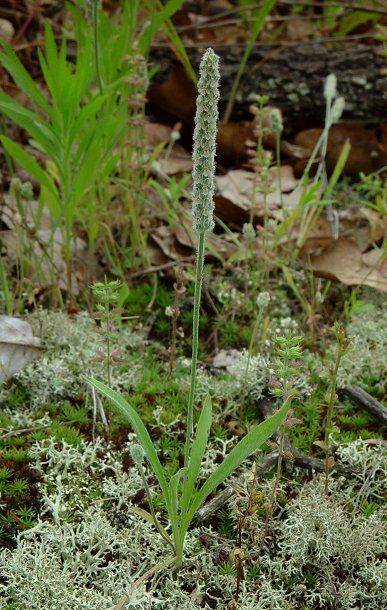Plantago patagonica Jacq.
Salt-And-Pepper Plant

Native
CC = 0
CW = 5
MOC = 11
SRank = S2
© DETenaglia
Plantago patagonica Jacq.Salt-And-Pepper Plant | |
 |
Native CC = 0 CW = 5 MOC = 11 SRank = S2 |
© DETenaglia |
|
Family - Plantaginaceae Habit - Annual or short-lived perennial forb, with taproots and later sometimes a short, sometimes branched rootstock. Stem - Aerial stems usually absent, or very short and inconspicuous (to 4 cm long with age) and unbranched.
Leaves - Basal, in a dense rosette, or alternate and crowded on a short stem, simple, sessile or with a short, poorly differentiated petiole, ascending. Blades 2-15 cm long, 1-7 mm wide, linear or narrowly oblanceolate, angled or tapered to a sharply pointed tip, long-tapered at the base, the margins entire, hairy, the surfaces moderately to more commonly densely woolly-and/or silky-hairy, appearing uniformly gray, with 1 main vein.
Inflorescences - Terminal, elongate spikes, 2-15 cm long, 7-11 mm in diameter (not including the bracts), 1 to several per plant, densely flowered (the axis not visible between the flowers), the stalk 5-20 cm long, hairy, the axis solid. Lowermost bracts 4-10 mm long, the other bracts 1-5 mm long, progressively shorter toward the spike tip, only the lowermost few to several sometimes extending past the flowers, variously lanceolate triangular with translucent marginal bands and a thickened midnerve to linear above a short, inconspicuous, translucent pair of basal wings, angled to long-tapered at the tip (this loosely ascending to somewhat arched in elongate bracts), densely hairy on both surfaces.
Flowers - Cleistogamous flowers usually abundant. Calyces deeply 4-lobed, 1.4-2.5 mm long, slightly zygomorphic, the lobes narrowly oblong-obovate to obovate, rounded at the tip, the upper pair with somewhat broader, papery margins than the lower pair. Corollas zygomorphic, the 4 lobes 1.2-2.2 mm long, broadly ovate to nearly circular with a shallowly cordate base, rounded to very bluntly pointed at the tip, the margins entire, the surfaces often appearing finely wrinkled, each with an inconspicuous brown base, otherwise white to somewhat translucent, the upper lobe slightly shorter than the others and ascending at flowering, the other lobes spreading, spreading to reflexed after flowering. Stamens 4, the anthers horned. Ovary superior, 2-locular.
Fruits - Capsules 3.0-3.5 mm long, ellipsoid to ovoid, circumscissile at or just below the midpoint. Seeds usually 2 per fruit, 2.0-2.8 mm long, oblong-elliptic, the surface deeply concave on 1 side, otherwise finely pitted, reddish brown, lighter in the concave portion. Flowering - May - August. Habitat - Upland prairies, loess hill prairies, glades, old quarries, railroads, roadsides, and open, sandy, disturbed areas. Origin - Native to the U.S. Lookalikes - P. virginica, P. aristata, P. wrightiana. Other info. - This little plant is found in a few scattered counties of Missouri, but its main range is to our west, primarily in the Plains and mountain states. At a glance it is easily mistaken for the far more common P. virginica, but that species has much wider leaves. It could also be mistaken for P. aristata, but that species has inflorescence bracts which extend conspicuously beyond the perimeter of the inflorescence, at least in mature specimens. Another key to identification is that P. patagonica has leaves which are moderately to densely hairy on both surfaces. Photographs taken at Dave Rock Conservation Area, St. Clair County, MO., 6-7-03 (DETenaglia); also at Blue River fishing and hunting reserve, Johnston County, OK, 5-25-2023 (SRTurner). |